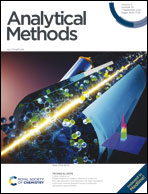A facile, inexpensive and green electrochemical sensor for sensitive detection of imidacloprid residue in rice using activated electrodes
Abstract
The development of sensitive, facile, cost-effective and eco-friendly sensors is essential for monitoring imidacloprid (IDP) residue on a large scale. Compared with popular modification of electrodes with advanced materials, electrochemical activation is promising at this point. In this paper, we found that strongly basic electrolytes (e.g. KOH and K3PO4) and applying cyclic potential during the activating process are beneficial to greatly amplify the electro-reduction response of IDP by nearly 16 times. Combining the characterization of activated electrodes with electrochemical behavior analysis of IDP, it is speculated that specific oxygen-contained functional groups were formed to bond with IDP molecules, leading to fast electron transfer kinetics. Then a sensitive IDP sensor has been developed with a low limit of detection (LOD) of 0.03 μM in the range of 0.1–100 μM. The methodological evaluation including reproducibility, stability and recovery has been also carefully studied, verifying the potential of proposed activated electrodes for application in rice samples.



 Please wait while we load your content...
Please wait while we load your content...